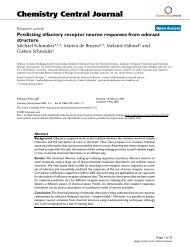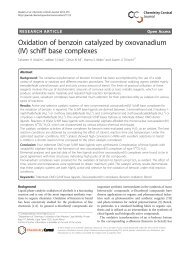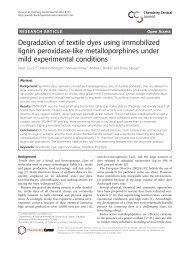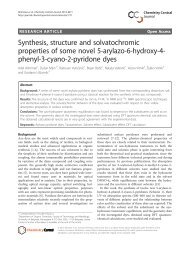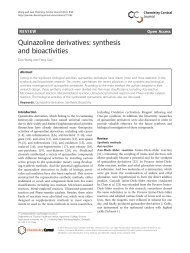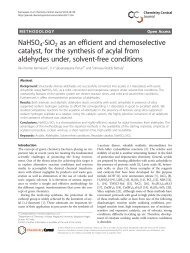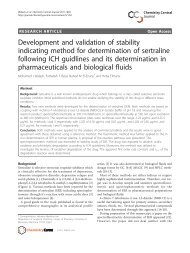Freezing point osmometry of milk to determine the additional water ...
Freezing point osmometry of milk to determine the additional water ...
Freezing point osmometry of milk to determine the additional water ...
Create successful ePaper yourself
Turn your PDF publications into a flip-book with our unique Google optimized e-Paper software.
Chemistry Central Journal<br />
Research article<br />
<strong>Freezing</strong> <strong>point</strong> <strong>osmometry</strong> <strong>of</strong> <strong>milk</strong> <strong>to</strong> <strong>determine</strong> <strong>the</strong> <strong>additional</strong><br />
<strong>water</strong> content – an issue in general quality control and German food<br />
regulation<br />
Britta Büttel*, Markus Fuchs and Birger Holz<br />
Open Access<br />
Address: Wissenschaftliche Gerätebau Dr. Ing. H. Knauer, Hegauer Weg 38, D-14163 Berlin, Berlin, Germany<br />
Email: Britta Büttel* - Buettel@knauer.net; Markus Fuchs - fuchs@knauer.net; Birger Holz - holz@knauer.net<br />
* Corresponding author<br />
Published: 10 March 2008<br />
Chemistry Central Journal 2008, 2:6 doi:10.1186/1752-153X-2-6<br />
Received: 29 November 2007<br />
Accepted: 10 March 2008<br />
This article is available from: http://journal.chemistrycentral.com/content/2/1/6<br />
© 2008 Büttel et al;<br />
This is an Open Access article distributed under <strong>the</strong> terms <strong>of</strong> <strong>the</strong> Creative Commons Attribution License (http://creativecommons.org/licenses/by/2.0),<br />
which permits unrestricted use, distribution, and reproduction in any medium, provided <strong>the</strong> original work is properly cited.<br />
Abstract<br />
Background: The determination <strong>of</strong> <strong>the</strong> osmolality <strong>of</strong> aqueous samples using a freezing <strong>point</strong><br />
osmometer is a well-established, routine labora<strong>to</strong>ry method. In addition <strong>to</strong> <strong>the</strong>ir use in clinical and<br />
pharmaceutical labora<strong>to</strong>ries, freezing <strong>point</strong> osmometers are also employed in food testing<br />
labora<strong>to</strong>ries. One application is <strong>the</strong> determination <strong>of</strong> <strong>the</strong> osmolality <strong>of</strong> <strong>milk</strong>. Although cow's <strong>milk</strong> is<br />
a natural product whose <strong>water</strong> content is approximately 87%, <strong>the</strong> osmolality <strong>of</strong> <strong>milk</strong> is a significant<br />
value when <strong>the</strong> <strong>milk</strong> is collected from a larger population <strong>of</strong> animals. This value is used in <strong>milk</strong><br />
processing <strong>to</strong> control <strong>the</strong> <strong>water</strong> content, based on <strong>the</strong> German Food Control Regulations for Milk.<br />
Results: Measurement <strong>of</strong> <strong>the</strong> freezing <strong>point</strong> and osmolality <strong>of</strong> <strong>milk</strong> samples was performed with a<br />
Knauer Semi-Micro <strong>Freezing</strong> Point Osmometer. Osmolality was measured for <strong>the</strong> untreated <strong>milk</strong><br />
samples and following <strong>the</strong>ir dilution (by volume) with 10% and 50% <strong>water</strong>. The measurements were<br />
made after 1, 4 and 7 days <strong>to</strong> evaluate changes over time. All measurement values for <strong>the</strong> undiluted<br />
<strong>milk</strong> were spread over a small interval with an average <strong>of</strong> 271 mOsmol/kg. After mixing <strong>the</strong> <strong>milk</strong><br />
samples with 10% <strong>water</strong>, <strong>the</strong> average decreased <strong>to</strong> 242 mOsmol/kg, while mixing with 50% <strong>water</strong><br />
resulted in an average osmolality <strong>of</strong> 129 mOsmol/kg. There was no significant change for <strong>the</strong><br />
osmolality within <strong>the</strong> 7 days (measurements from days 1, 4 and 7).<br />
Conclusion: The results observed demonstrate clearly that <strong>the</strong> <strong>additional</strong> <strong>water</strong> content <strong>of</strong> <strong>milk</strong><br />
can be <strong>determine</strong>d easily using a freezing <strong>point</strong> osmometer. Milk samples that contain <strong>additional</strong><br />
<strong>water</strong> have a significantly decreased osmolality, corresponding <strong>to</strong> an increased freezing <strong>point</strong>. The<br />
effect on osmolality <strong>of</strong> ageing <strong>the</strong> <strong>milk</strong> samples could not be <strong>determine</strong>d in this study's timedependent<br />
measurements.<br />
Background<br />
The determination <strong>of</strong> aqueous samples' osmolality using<br />
a freezing <strong>point</strong> osmometer is a well-established, routine<br />
labora<strong>to</strong>ry method. In vitro diagnosis in <strong>the</strong> clinical labora<strong>to</strong>ry<br />
is regularly based upon blood serum and urine<br />
osmolality. Detection <strong>of</strong> diseases and <strong>the</strong>rapy control are<br />
<strong>the</strong> main targets [1,2]. The freezing <strong>point</strong> osmometer is<br />
also in use in <strong>the</strong> food labora<strong>to</strong>ry, where its main applications<br />
are in <strong>the</strong> determination <strong>of</strong> alcohol content in beverages<br />
and quality control <strong>of</strong> o<strong>the</strong>r additives [3]. Because<br />
<strong>the</strong> definition <strong>of</strong> osmolality is <strong>the</strong> number <strong>of</strong> solute molecules<br />
that are dissolved in 1 kg <strong>of</strong> solvent (<strong>water</strong> in this<br />
Page 1 <strong>of</strong> 7<br />
(page number not for citation purposes)
Chemistry Central Journal 2008, 2:6<br />
http://journal.chemistrycentral.com/content/2/1/6<br />
case), in all <strong>the</strong>se applications <strong>the</strong> solute is that which is<br />
<strong>determine</strong>d by <strong>osmometry</strong>. When <strong>milk</strong> is measured, its<br />
<strong>additional</strong> <strong>water</strong> content is <strong>the</strong> most important fac<strong>to</strong>r for<br />
<strong>the</strong> determination <strong>of</strong> <strong>milk</strong> osmolality [4,5].<br />
Cow's <strong>milk</strong> is a natural product and contains many different<br />
components including fat, <strong>milk</strong> sugar, protein, minerals,<br />
and approximately 87% <strong>water</strong> [6]. All components are<br />
dependent upon natural deviations <strong>determine</strong>d by <strong>the</strong><br />
cow's race, feeding, age and o<strong>the</strong>r environmental fac<strong>to</strong>rs.<br />
However, <strong>the</strong> osmolality <strong>of</strong> <strong>milk</strong> is a significant value<br />
owing <strong>to</strong> its being highly preserved even when collected<br />
from a larger population <strong>of</strong> animals and pooled before<br />
fur<strong>the</strong>r processing. Osmolality has <strong>the</strong>refore been used for<br />
quality control <strong>of</strong> this natural product for quite a while<br />
[7].<br />
The quality <strong>of</strong> <strong>the</strong> <strong>milk</strong> <strong>to</strong> be processed fur<strong>the</strong>r is controlled<br />
by <strong>the</strong> German Food Regulations for Milk [8]. One<br />
part <strong>of</strong> this regulation concerns <strong>the</strong> <strong>water</strong> content as measured<br />
by its freezing <strong>point</strong>. Because this parameter is highly<br />
preserved, it is convenient <strong>to</strong> control <strong>the</strong> quality in a<br />
pooled fraction because <strong>the</strong> result can be transferred <strong>to</strong> <strong>the</strong><br />
whole lot. While fat or carbohydrate content can vary<br />
within individuals over time as well as in and between<br />
populations, <strong>water</strong> content is a preserved parameter,<br />
changed by external fac<strong>to</strong>rs. Whenever <strong>milk</strong> processing<br />
takes place, <strong>additional</strong> <strong>water</strong> may be mixed in<strong>to</strong> <strong>the</strong> <strong>milk</strong>.<br />
This can occur because <strong>of</strong> <strong>the</strong> presence <strong>of</strong> <strong>water</strong> in <strong>the</strong><br />
<strong>milk</strong>ing machine pipes or any o<strong>the</strong>r kind <strong>of</strong> dilution with<br />
<strong>water</strong> at <strong>the</strong> <strong>milk</strong> producer's site. The freezing <strong>point</strong> is not<br />
<strong>to</strong> exceed a value <strong>of</strong> -0.515°C as mentioned in <strong>the</strong> food<br />
regulations concerning <strong>milk</strong>. If exceeded, <strong>the</strong> product is<br />
not permitted for use in fur<strong>the</strong>r food processing and has<br />
<strong>to</strong> be discarded owing <strong>to</strong> its having probably been diluted<br />
with <strong>water</strong>.<br />
This study used several freezing <strong>point</strong> osmometers <strong>to</strong><br />
<strong>determine</strong> <strong>the</strong> osmolality in aqueous solutions by a specific<br />
decrease <strong>of</strong> <strong>the</strong> freezing <strong>point</strong> compared <strong>to</strong> that <strong>of</strong><br />
pure <strong>water</strong>. A depression <strong>of</strong> <strong>the</strong> freezing temperature <strong>of</strong> a<br />
<strong>milk</strong> sample compared <strong>to</strong> a reference <strong>milk</strong> sample indicated<br />
that <strong>the</strong> <strong>milk</strong> sample was contaminated with a soluble<br />
component. While most labora<strong>to</strong>ries use only one<br />
instrument, in our labora<strong>to</strong>ry five instruments were precisely<br />
calibrated for <strong>the</strong> purpose <strong>of</strong> this study. Certified<br />
solutions [9] <strong>to</strong>ge<strong>the</strong>r with a number <strong>of</strong> dilution experiments<br />
were used in order <strong>to</strong> validate measurement equipment<br />
and provide an accurate calibration <strong>of</strong> every<br />
instrument included in <strong>the</strong> study. Blind samples were<br />
used <strong>to</strong> exclude effects originating from packing material,<br />
glass vessels and measurement tubes. When <strong>the</strong> <strong>water</strong><br />
content <strong>of</strong> <strong>milk</strong> is raised, i.e. <strong>the</strong> number <strong>of</strong> diluted particles<br />
per kilogram sample is reduced, this can be identified<br />
by an elevation <strong>of</strong> <strong>the</strong> freezing <strong>point</strong> <strong>to</strong>wards 0°C. Vice<br />
versa, <strong>the</strong> number <strong>of</strong> particles dissolved in 1 kg <strong>of</strong> sample<br />
is directly proportional <strong>to</strong> <strong>the</strong> decrease <strong>of</strong> <strong>the</strong> freezing temperature.<br />
This study covers <strong>the</strong> measurement <strong>of</strong> undiluted<br />
cow's <strong>milk</strong> taken from conventional packages and dilutions<br />
with pure (0 mOsmol/kg) <strong>water</strong> by 10% or 50% by<br />
volume. Dissociation <strong>of</strong> sample molecules over time was<br />
evaluated by re-measurement exactly 4 and 7 days after<br />
<strong>the</strong> undiluted samples had been opened and measured.<br />
The aim <strong>of</strong> this study was <strong>to</strong> <strong>determine</strong> exactly <strong>the</strong> osmolality<br />
<strong>of</strong> real <strong>milk</strong> samples.<br />
Results<br />
The distribution <strong>of</strong> measured osmolalities is shown in Figure<br />
1 (n = 12). The 4 individual measurements give m =<br />
48 measurements <strong>of</strong> untreated (undiluted) samples.<br />
All individual measurement values were spread within a<br />
small interval between 263 and 282 mOsmol/kg. The<br />
majority <strong>of</strong> values were close <strong>to</strong> 269 mOsmol/kg. The<br />
average value <strong>of</strong> all single measurements was 271 mOsmol/kg.<br />
The standard deviation was 5.1 mOsmol/kg, with<br />
<strong>the</strong> whole interval being about 19 mOsmol/kg, which is<br />
far less than 10% <strong>of</strong> <strong>the</strong> mean.<br />
Addition <strong>of</strong> <strong>water</strong> <strong>to</strong> <strong>the</strong> <strong>milk</strong> sample can be observed<br />
when <strong>the</strong> decrease in <strong>the</strong> samples' osmolality was measured<br />
(Figure 2). Collecting <strong>the</strong> same data as shown in Figure<br />
1 for <strong>the</strong> diluted <strong>milk</strong> samples (b: <strong>milk</strong> + 10 vol.%<br />
<strong>water</strong> and c: <strong>milk</strong> + 50 vol.% <strong>water</strong>) osmolality values<br />
showed a significant decrease compared <strong>to</strong> <strong>the</strong> undiluted<br />
<strong>milk</strong> (a).<br />
The average osmolality <strong>of</strong> undiluted <strong>milk</strong> samples was<br />
271 mOsmol/kg. After mixing with 10% <strong>water</strong> by volume,<br />
<strong>the</strong> average decreased <strong>to</strong> 242 mOsmol/kg. When mixing<br />
<strong>milk</strong> with <strong>the</strong> same volume <strong>of</strong> <strong>water</strong> (50% <strong>water</strong>) <strong>the</strong><br />
resulting mean osmolality was 129 mOsmol/kg. The<br />
decrease in osmolality effected by dilution was 2.9 mOsmol/kg/1%<br />
dilution in <strong>the</strong> <strong>determine</strong>d range (0% <strong>to</strong> 50%<br />
<strong>water</strong>) (Figure 3).<br />
No significant change in osmolality was observed for all<br />
samples 1, 4 and 7 days after opening <strong>the</strong> packaging, nei<strong>the</strong>r<br />
for <strong>the</strong> individual measurement (m = 144) nor for <strong>the</strong><br />
averaged sample value (n day 1 + 4 + 7 = 36). Figure 4<br />
shows individual measurements for samples 14, 15, and<br />
16. Table 1 shows <strong>the</strong> average result and standard deviation<br />
for each sample. Missing values in Table 1 represent<br />
failed measurements, where <strong>the</strong> <strong>milk</strong> sample froze <strong>to</strong>o<br />
early or did not freeze at all.<br />
Discussion and Conclusion<br />
From an analytical <strong>point</strong> <strong>of</strong> view, <strong>milk</strong> is a ra<strong>the</strong>r complicated<br />
sample. Although <strong>the</strong> content <strong>of</strong> fat, carbohydrate<br />
and o<strong>the</strong>r ingredients may vary with <strong>the</strong> feeding and<br />
Page 2 <strong>of</strong> 7<br />
(page number not for citation purposes)
Chemistry Central Journal 2008, 2:6<br />
http://journal.chemistrycentral.com/content/2/1/6<br />
number <strong>of</strong> samples measured <strong>to</strong> have<br />
a certain osmolality<br />
number <strong>of</strong> samples m<br />
10<br />
5<br />
0<br />
260 265 270 275 280 285<br />
mOsmol/kg<br />
Milk Figure sample 1 osmolality by sample number<br />
Milk sample osmolality by sample number. Number <strong>of</strong> samples measured <strong>to</strong> have a certain osmolality.<br />
health status <strong>of</strong> <strong>the</strong> animal, <strong>the</strong> <strong>to</strong>tal osmolality value is<br />
preserved in a ra<strong>the</strong>r small interval. Since <strong>the</strong> fat content<br />
<strong>of</strong> <strong>milk</strong> has, if any, only a very small influence on <strong>the</strong> <strong>milk</strong><br />
samples' osmolality [10], <strong>the</strong> results are not discussed<br />
with respect <strong>to</strong> this parameter.<br />
The natural <strong>water</strong> content <strong>of</strong> <strong>milk</strong> only varies <strong>to</strong> preserve<br />
osmolality. This makes it possible <strong>to</strong> measure <strong>additional</strong><br />
<strong>water</strong> content in terms <strong>of</strong> changes in osmolality. The<br />
measurements in this study were made with regular processed<br />
unskimmed <strong>milk</strong>; <strong>the</strong> same method can be used <strong>to</strong><br />
<strong>determine</strong> <strong>the</strong> <strong>additional</strong> <strong>water</strong> content in fresh<br />
unskimmed <strong>milk</strong> or with intermediate products during<br />
food processing. Also, partly skimmed <strong>milk</strong> or <strong>milk</strong> with<br />
reduced fat content can also be measured [11]. All measurement<br />
values in this study gave an average <strong>of</strong> 271 mOs-<br />
number <strong>of</strong> samples m<br />
10<br />
5<br />
undiluted sample<br />
90% (+10% <strong>water</strong>)<br />
50% (+50% <strong>water</strong>)<br />
c<br />
b<br />
a<br />
0<br />
118 138 158 178 198 218 238 258 278<br />
mOsmol/kg<br />
Dilution Figure 2<strong>of</strong> <strong>milk</strong> samples<br />
Dilution <strong>of</strong> <strong>milk</strong> samples. a: undiluted sample; b: 90% (+10% <strong>water</strong>); c: 50% (+50% <strong>water</strong>).<br />
Page 3 <strong>of</strong> 7<br />
(page number not for citation purposes)
Chemistry Central Journal 2008, 2:6<br />
http://journal.chemistrycentral.com/content/2/1/6<br />
300,00<br />
250,00<br />
osmolality [mOsmol/kg]<br />
200,00<br />
150,00<br />
100,00<br />
50,00<br />
0,00<br />
0 10 20 30 40 50 60<br />
dilution <strong>of</strong> <strong>milk</strong> [vol.% H20]<br />
Osmolality Figure 3 <strong>of</strong> <strong>milk</strong> as a function <strong>of</strong> dilution with <strong>water</strong><br />
Osmolality <strong>of</strong> <strong>milk</strong> as a function <strong>of</strong> dilution with <strong>water</strong>.<br />
mol/kg. This value is 2.2% less compared <strong>to</strong> <strong>the</strong> average<br />
recommended by <strong>the</strong> German Food Regulation (-0.515°C<br />
corresponds <strong>to</strong> 277 mOsmol/kg). This slightly decreased<br />
osmolality and increased <strong>water</strong> content can be explained<br />
by <strong>the</strong> fact that ready packed <strong>milk</strong> was evaluated in this<br />
study.<br />
The results observed demonstrate clearly that <strong>the</strong> <strong>additional</strong><br />
<strong>water</strong> content <strong>of</strong> <strong>milk</strong> with different origins can be<br />
easily <strong>determine</strong>d using a freezing <strong>point</strong> osmometer. Milk<br />
samples that show <strong>additional</strong> <strong>water</strong> content have a significantly<br />
decreased osmolality, or an increased freezing<br />
<strong>point</strong>. With <strong>the</strong> addition <strong>of</strong> 10 vol.% <strong>water</strong>, osmolality is<br />
increased by 29 mOsmol/kg. This value shows <strong>the</strong> sensitivity<br />
<strong>of</strong> <strong>the</strong> method: 2.9 mOsmol/kg per % <strong>water</strong>, which<br />
is ra<strong>the</strong>r linear in <strong>the</strong> range <strong>of</strong> 0 – 50% <strong>additional</strong> <strong>water</strong><br />
(see Figure 3). With higher dilution <strong>the</strong> activity coefficient<br />
reflects <strong>the</strong> degree <strong>of</strong> fur<strong>the</strong>r dissociation and lower salt<br />
concentration and makes <strong>the</strong> effect <strong>of</strong> <strong>additional</strong> <strong>water</strong><br />
content on osmolality more complex, i.e. non-linear.<br />
However, <strong>the</strong> method produces stable and significant values<br />
for <strong>the</strong> dilution <strong>of</strong> <strong>milk</strong> samples.<br />
The effects on osmolality <strong>of</strong> ageing <strong>milk</strong> samples could<br />
not be <strong>determine</strong>d in <strong>the</strong> time-dependent measurements<br />
<strong>of</strong> this study (days 1, 4 and 7, compare Figure 4). According<br />
<strong>to</strong> Chen this is expected for highly concentrated <strong>milk</strong><br />
samples only [10].<br />
The method described in this paper is a standard method<br />
in <strong>the</strong> German Food Regulation for Milk [8] and <strong>the</strong> <strong>additional</strong><br />
<strong>water</strong> content must be <strong>determine</strong>d according <strong>to</strong> it.<br />
The <strong>additional</strong> <strong>water</strong> content and not <strong>the</strong> <strong>to</strong>tal <strong>water</strong> content<br />
are <strong>to</strong> be <strong>determine</strong>d. This is a relative measurement<br />
comparing <strong>the</strong> results <strong>to</strong> a calibration solution and can be<br />
performed using a simple and easy-<strong>to</strong>-use <strong>Freezing</strong> Point<br />
Osmometer. If cleaning <strong>of</strong> <strong>the</strong> pipelines in <strong>the</strong> <strong>milk</strong><br />
processing does not lead <strong>to</strong> a dilution with cleaning <strong>water</strong>,<br />
but <strong>to</strong> pollution <strong>of</strong> <strong>the</strong> <strong>milk</strong> with cleaning acid or neutralizing<br />
agents (residual salts), this could also be <strong>determine</strong>d<br />
by measuring <strong>the</strong> freezing <strong>point</strong> <strong>of</strong> <strong>the</strong> <strong>milk</strong> – a depression<br />
<strong>of</strong> <strong>the</strong> freezing <strong>point</strong> corresponds <strong>to</strong> an increase in osmolality.<br />
Alternative measurement methods for <strong>water</strong> content are<br />
mainly used for determining residual amounts <strong>of</strong> <strong>water</strong> in<br />
<strong>milk</strong> products along <strong>the</strong> food processing line, such as<br />
cheese, butter or food made <strong>of</strong> <strong>milk</strong> or <strong>milk</strong> products. The<br />
<strong>to</strong>tal <strong>water</strong> content <strong>of</strong> <strong>the</strong>se samples is <strong>determine</strong>d, for<br />
instance, by <strong>the</strong> Karl-Fischer titration, pulsed NMR spectroscopy,<br />
or gas humidity measurements using phosphorus<br />
pen<strong>to</strong>xide or drying in <strong>the</strong> infrared beam. These<br />
methods are not suitable for determining <strong>the</strong> <strong>additional</strong><br />
<strong>water</strong> content <strong>of</strong> <strong>milk</strong>, because <strong>the</strong>y cannot be applied <strong>to</strong><br />
samples with high <strong>to</strong>tal <strong>water</strong> content, such as <strong>milk</strong>.<br />
Experimental<br />
Measurement <strong>of</strong> <strong>the</strong> freezing <strong>point</strong> and osmolality <strong>of</strong> <strong>milk</strong><br />
samples were performed with <strong>the</strong> KNAUER Semi-Micro<br />
Page 4 <strong>of</strong> 7<br />
(page number not for citation purposes)
Chemistry Central Journal 2008, 2:6<br />
http://journal.chemistrycentral.com/content/2/1/6<br />
Osmolality [mOsmol/kg]<br />
300<br />
275<br />
250<br />
225<br />
200<br />
175<br />
150<br />
125<br />
100<br />
1 2 3 4 5 6 7<br />
measurement at day no.<br />
sample 14: +0% <strong>water</strong><br />
14: +10% <strong>water</strong><br />
14: +50% <strong>water</strong><br />
sample 15: +0% <strong>water</strong><br />
15: +10% <strong>water</strong><br />
15: +50% <strong>water</strong><br />
sample 16: +0% <strong>water</strong><br />
16: +10% <strong>water</strong><br />
16: +50% <strong>water</strong><br />
Individual Figure 4 measurements at days 1, 4 and 7<br />
Individual measurements at days 1, 4 and 7.<br />
Osmometer K-7400 (KNAUER, Berlin, Germany, Order<br />
No. A3707) as a stand-alone instrument (instrument #1)<br />
or <strong>to</strong>ge<strong>the</strong>r with EuroOsmo 7400 control and data acquisition<br />
s<strong>of</strong>tware (Order No. A3705; instrument #2). Sample<br />
vials were made <strong>of</strong> glass (Order No. A0913), and<br />
calibration solutions were ei<strong>the</strong>r 300 mOsmol/kg (Order<br />
No.Y1240) or 400 mOsmol/kg (Order No.Y1241) solution<br />
consisting <strong>of</strong> sodium chloride in <strong>water</strong>. Cleaning<br />
solution (Order No. Y1277) was used for cleaning <strong>the</strong><br />
measurement head. Instruments #3, #4, and #5 were used<br />
as reference instruments and were calibrated with a urine<br />
control solution (Bio-Rad, Redmond, CA, USA, Order No.<br />
435).<br />
Before starting a series <strong>of</strong> measurements, <strong>the</strong> <strong>Freezing</strong><br />
Point Osmometers K-7400 were calibrated using pure<br />
<strong>water</strong> (osmolality 0) and one <strong>of</strong> <strong>the</strong> calibration solutions,<br />
ei<strong>the</strong>r 300 mOsmol/kg or 400 mOsmol/kg. The instrument<br />
was set <strong>to</strong> display <strong>the</strong> freezing <strong>point</strong> temperature<br />
instead <strong>of</strong> <strong>the</strong> osmolality result (cryostat mode). The<br />
results <strong>of</strong> <strong>the</strong> calibration are shown in Table 2.<br />
Exactly 150 µl <strong>of</strong> <strong>the</strong> calibration solution or <strong>the</strong> <strong>milk</strong> sample<br />
were measured in<strong>to</strong> a glass vial using an Eppendorf<br />
pipette. The measurement vial was <strong>the</strong>n carefully placed<br />
over <strong>the</strong> <strong>the</strong>rmis<strong>to</strong>r and head wire on <strong>the</strong> measurement<br />
head. After starting <strong>the</strong> measurement, <strong>the</strong> run proceeded<br />
and terminated au<strong>to</strong>matically. The sample was cooled<br />
down slowly below <strong>the</strong> freezing <strong>point</strong> and if a previously<br />
selected temperature was reached, <strong>the</strong> wire was moved<br />
in<strong>to</strong> <strong>the</strong> vial <strong>to</strong> initiate freezing. The crystallisation heat<br />
raises <strong>the</strong> temperature immediately until <strong>the</strong> freezing temperature<br />
has been reached. When <strong>the</strong> temperature curve<br />
shows a plateau, this freezing <strong>point</strong> temperature was<br />
taken as <strong>the</strong> measurement value and <strong>the</strong> concentration in<br />
mOsmol/kg was calculated based upon <strong>the</strong> calibration<br />
curve s<strong>to</strong>red in <strong>the</strong> instrument. The final concentration<br />
was displayed on <strong>the</strong> s<strong>of</strong>tware interface.<br />
Between different samples, <strong>the</strong> measurement head <strong>the</strong>rmis<strong>to</strong>r<br />
was carefully wiped with a lint-free paper <strong>to</strong>wel.<br />
After 4 repeat measurements with one sample, <strong>the</strong> <strong>the</strong>rmis<strong>to</strong>r<br />
and <strong>the</strong> wire <strong>of</strong> <strong>the</strong> measurement head were<br />
washed with distilled <strong>water</strong> (maximum allowed osmolality<br />
= 2) and <strong>the</strong>n with diluted cleaning solution and again<br />
with distilled <strong>water</strong>. The measurement head was dried<br />
with a lint-free paper <strong>to</strong>wel or air-dried before starting <strong>the</strong><br />
next measurement.<br />
The samples were taken from 12 conventional cow's <strong>milk</strong><br />
packages, eleven <strong>of</strong> <strong>the</strong>se in paper-aluminum packages<br />
and one in a glass bottle. Three fresh <strong>milk</strong> diary products<br />
(pasteurized <strong>milk</strong>) and nine long-life <strong>milk</strong> products (UHT<br />
<strong>milk</strong>) were randomly chosen for this study. The fat content<br />
in <strong>the</strong> fresh <strong>milk</strong> varied from 3.5% <strong>to</strong> 3.8% (w/v),<br />
while long-life <strong>milk</strong> had 3.5% for all samples tested. Nine<br />
registered <strong>milk</strong> producers were <strong>the</strong> manufacturers <strong>of</strong> <strong>the</strong><br />
tested products. The osmolality <strong>of</strong> <strong>the</strong> <strong>milk</strong> samples was<br />
measured for <strong>the</strong> untreated <strong>milk</strong> and when diluted with<br />
10% and 50% pure <strong>water</strong> by volume.<br />
Page 5 <strong>of</strong> 7<br />
(page number not for citation purposes)
Chemistry Central Journal 2008, 2:6<br />
http://journal.chemistrycentral.com/content/2/1/6<br />
Table 1: Mean results <strong>of</strong> all samples<br />
Sample no. dilution [%] with H 2 O mean Osmolality [mOsmol/kg]<br />
day 1 day 4 day 7<br />
standart deviation standart deviation standart deviation<br />
1a 0 269,3 1,5 270,8 4,4 268,3 0,6<br />
1b 10 242,3 2,9 241,7 2,5 241,2 2,5<br />
1c 50 131,7 1,5 134,3 0,6 130,8 2,9<br />
2a 0 266,7 2,3 267,0 2,7 272,3 3,3<br />
2b 10 239,0 2,7 237,2 2,8 240,5 1,3<br />
2c 50 130,0 2,9 127,3 1,2 129,0 1,0<br />
3a 0 269,0 0,0 270,0 2,3 272,0 3,0<br />
3b 10 239,7 2,5 240,5 1,9 243,0 2,6<br />
3c 50 132,3 1,2 130,8 3,3 135,3 2,1<br />
7a 0 277,0 1,8 276,3 1,0 275,0 2,0<br />
7b 10 244,0 2,4 244,3 2,8 243,0 0,8<br />
7c 50 129,0 0,8 129,8 3,3 129,5 1,3<br />
8a 0 278,5 1,3 276,0 2,2 278,8 3,4<br />
8b 10 247,3 1,7 243,5 3,1 248,0 2,6<br />
8c 50 130,3 0,6<br />
9a 0 279,3 2,2 279,5 1,0 277,0 0,8<br />
9b 10 247,8 1,5 245,8 1,3 246,8 1,3<br />
9c 50 129,7 2,3 130,0 2,2 131,5 1,3<br />
11a 0 268,5 3,8 273,6 1,7 278,4 2,1<br />
11b 10 242,3 2,5 243,0 1,4 248,8 0,5<br />
11c 50 129,0 3,9 128,5 2,1 131,3 2,5<br />
12a 0 265,8 1,7 269,3 1,3 274,5 0,6<br />
12b 10 239,7 5,4 237,5 1,0 244,5 1,3<br />
12c 50 127,8 1,7 124,5 0,6 131,5 1,7<br />
13a 0 271,3 0,6 272,5 1,9 275,0 1,4<br />
13b 10 238,6 3,4 241,8 1,5 245,3 1,7<br />
13c 50 127,2 2,6 126,3 1,7 131,8 1,5<br />
14a 0 271,3 2,8 270,0 1,7 269,5 2,1<br />
14b 10 240,7 2,3 241,3 4,0 244,3 4,0<br />
14c 50 127,8 3,6 129,0 3,5 128,8 1,3<br />
15a 0 267,3 2,6 270,3 5,5 271,5 3,7<br />
15b 10 239,0 2,0 240,5 5,4 241,3 3,5<br />
15c 50 129,0 1,8 134,0 1,0 128,7 1,2<br />
16a 0 268,7 2,3 269,0 1,4 274,7 1,5<br />
16b 10 242,3 4,9 240,5 5,1 242,3 2,5<br />
16c 50 129,3 0,6 128,7 3,2 132,5 2,1<br />
To obtain a 10% vol. dilution, 4.6 ml <strong>of</strong> <strong>the</strong> corresponding<br />
<strong>milk</strong> sample and 0.4 ml <strong>of</strong> pure <strong>water</strong> were mixed in a<br />
5 ml glass vessel. To exclude effects from <strong>the</strong> glass vessel,<br />
one <strong>additional</strong> vessel was filled with 5.0 ml <strong>of</strong> <strong>water</strong>,<br />
closed and treated in <strong>the</strong> same way as <strong>the</strong> samples. This<br />
extra <strong>water</strong> sample was proven <strong>to</strong> have 0 or 1 mOsmol/kg<br />
after <strong>the</strong> same incubation time. Every sample was shaken<br />
for 1 min after capping with a PTFE coated septum/aluminum<br />
cap and s<strong>to</strong>red in<strong>to</strong> <strong>the</strong> refrigera<strong>to</strong>r for 10 min before<br />
Table 2: <strong>Freezing</strong> <strong>point</strong> <strong>of</strong> <strong>water</strong> and calibration solution<br />
Calibration Solution [mOsmol/kg]<br />
<strong>Freezing</strong> Point Temperature [°C]<br />
0 -0.000<br />
300 -0.557<br />
400 -0.743<br />
measurement. A 50% sample was prepared by mixing 2.5<br />
ml <strong>of</strong> <strong>milk</strong> with 2.5 ml <strong>of</strong> <strong>water</strong> and treated in <strong>the</strong> same<br />
way. To avoid foam, <strong>the</strong> samples were shaken carefully.<br />
The volumes 4.6 and 2.5 ml were pipetted using a glass<br />
syringe that had been cleaned with pure <strong>water</strong> before use.<br />
A measurement value was taken for days 1 (maximum 30<br />
min after opening <strong>the</strong> package), 4 and 7 <strong>to</strong> evaluate<br />
changes over time. Between measurements, <strong>the</strong> <strong>milk</strong> was<br />
s<strong>to</strong>red in a refrigera<strong>to</strong>r at 4°C. Every sample at every dilution<br />
and time interval was measured about four times.<br />
Authors' contributions<br />
The authors contributed equally <strong>to</strong> this work.<br />
Page 6 <strong>of</strong> 7<br />
(page number not for citation purposes)
Chemistry Central Journal 2008, 2:6<br />
http://journal.chemistrycentral.com/content/2/1/6<br />
References<br />
1. Mohn A, Acerini CL, Cheetham TD, Lightman SL, Dunger DB:<br />
Hyper<strong>to</strong>nic saline test for <strong>the</strong> investigation <strong>of</strong> posterior pituitary<br />
function. Arch Dis Child 1998, 79:431-434.<br />
2. Janssen WMT, de Zeeuw D, van der Hem GK, de Jong PE: Atrial<br />
Natriuretic Fac<strong>to</strong>r-Induced Decreases in Renal Blood Flow<br />
in Man: Implications for <strong>the</strong> Natriuretic Mechanism. Clin Sci<br />
1989, 77:55-60.<br />
3. Wesley JF: Osmolality – A Novel and Sensitive Tool for Detection<br />
<strong>of</strong> tampering <strong>of</strong> Beverages Adulterated with Ethanol, γ-<br />
Butyrolac<strong>to</strong>ne, and 1,4-Butanediol, and for Detection <strong>of</strong><br />
Dilution-Tampered Demerol Syringes. Microgram Journal 2003,<br />
1(1–2):8-17.<br />
4. Krumm OH: Über die Variation von Inhaltsst<strong>of</strong>fen der Kuhmilch.<br />
Diss., Justus Liebig-Universität Giessen; 1972.<br />
5. Rosenthal I: Milk and Diary Products: Properties and Processing.<br />
Rehovot, Balaban Publ; 1991.<br />
6. Töpel A: Chemie und Physik der Milch: Naturst<strong>of</strong>f, Rohst<strong>of</strong>f,<br />
Lebensmittel. 1st edition. Hamburg, Bahr; 2004.<br />
7. Jackson LC, Ro<strong>the</strong>ra ACH: Milk – Its Milk Sugar, Conductivity<br />
and Depression <strong>of</strong> <strong>Freezing</strong> Point. 1913:1-27.<br />
8. Milchgüteverordnung. In Wikipedia, Die freie Enzyklopädie Volume<br />
16. Bearbeitungsstand: UTC :01. 20. Mai 2007 [http://de.wikipedia.org/wiki/Milchgüteverordnung]<br />
9. B. Braun (Melsungen) 400 mOsmol/kg certified test solution,<br />
Bio-Rad Urinalysis Control solution lot no. 61270. .<br />
10. Chen P, Chen XD, Free KW: Measurement and Data Interpretation<br />
<strong>of</strong> <strong>the</strong> <strong>Freezing</strong> Point Depression <strong>of</strong> Milk. Journal <strong>of</strong> Food<br />
Engineering 1996, 30:239-253.<br />
11. Schweizer Lebensmittelbuch SLMB [homepage on <strong>the</strong><br />
Internet] Bern: Eidgenössisches Department des Innern: Bundesamt für<br />
Gesundheit BAG, chapter: 01: Milch 2005 [http://<br />
www.slmb.bag.admin.ch].<br />
Publish with ChemistryCentral and every<br />
scientist can read your work free <strong>of</strong> charge<br />
Open access provides opportunities <strong>to</strong> our<br />
colleagues in o<strong>the</strong>r parts <strong>of</strong> <strong>the</strong> globe, by allowing<br />
anyone <strong>to</strong> view <strong>the</strong> content free <strong>of</strong> charge.<br />
W. Jeffery Hurst, The Hershey Company.<br />
available free <strong>of</strong> charge <strong>to</strong> <strong>the</strong> entire scientific community<br />
peer reviewed and published immediately upon acceptance<br />
cited in PubMed and archived on PubMed Central<br />
yours you keep <strong>the</strong> copyright<br />
Submit your manuscript here:<br />
http://www.chemistrycentral.com/manuscript/<br />
Page 7 <strong>of</strong> 7<br />
(page number not for citation purposes)





